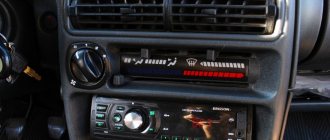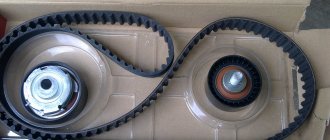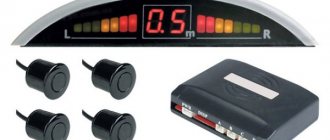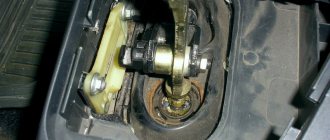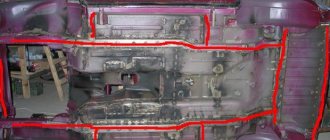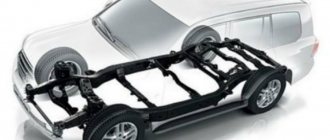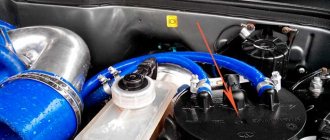The electronic engine control unit (ECU) will perform a number of important functions, fully controlling the operation of the internal combustion engine in different modes. This control unit is actually the basis of the ECM, since the device receives data from various sensors, after which the received information is processed according to specified algorithms.
The block then sends appropriate commands to different actuators. This scheme makes it possible to achieve significant optimization of many processes that occur in the engine, as well as to force the motor to operate within strictly specified parameters. As a result, it is possible to reduce fuel consumption, increase engine power, ensure complete combustion of the fuel-air mixture in the cylinders, reduce the toxicity of exhaust gases, etc.
Let us immediately note that the so-called “brains” of the engine in modern cars are made in such a way that a number of parameters that are hardwired into their memory can be changed programmatically. Next, we will talk about where the engine control unit is located on different cars, and also consider the main functions and features of the electronic controller.
What does the ECU control?
To begin with, I will list the sensors from which it collects information:
- Engine temperature
- Ambient temperature
- Oxygen supply
- Fuel supply
- Idle move
- Sensors for anti-lock braking system, stabilization, anti-skid, and other wheel safety systems
- Speed
- Throttle position
- Gas pedal position
- Crankshaft (sometimes there are two)
- Coolant monitoring
- Air conditioning sensor and its system
- Monitoring the brake system and its fluid
- Data from the power steering reservoir or from the EUR circuit
- On-board power supply voltage analysis
This is a standard set that is found on almost any car; if your car is more “sophisticated”, then the number of sensors will be greater, suspension sensors may be added here, for example, on some SUVs it is pneumatic.
Now I will list who the ECU gives orders to, that is, sends commands:
- This is the throttle position + air supply
- Fuel supply (injector injection)
- Ignition system
- Valve timing control
- Temperature control and maintenance
- Exhaust gas analysis, before and after the catalyst
- Air conditioning system
- The lighting system, and other electrical equipment, sometimes even a radio tape recorder
- Window lifters
- Warming up
- Automatic transmission control
Again, guys, this is the minimum standard set, if your car is of a higher class than people's foreign cars, there will be much more such teams.
As you can see, this small box keeps the entire car under control, that is, all systems and sensors are connected to it.
Many of my readers think that this unit is directly similar to a computer, or at least a laptop, only without a display. This alone is not true! Its form factor is completely different.
History[edit]
Early developments[edit]
One of the first attempts to use such a unified and automated device to control multiple engine control functions simultaneously was the Kommandogerät created by BMW in 1939 for their 801 14-cylinder aircraft radial engine. [3] This device replaced the 6 controls used to initiate hard acceleration with a single control device on the 801 series aircraft. However, it had some problems: it drove the engine, making it difficult for the Fw 190 to fly in close formation ( Focke-Wulf Fw 190 Wurger), a German single-seat fighter, and at first it included a supercharger. changes gears abruptly and erratically, which can result in an extremely dangerous stall of the aircraft.
The development of integrated circuits and microprocessors made motor control economically feasible in the 1970s. In the early 1970s, the Japanese electronics industry began producing integrated circuits and microcontrollers to control Japanese automobile engines. [4] Ford's EEC (Electronic Engine Control) system, which used the Toshiba TLCS-12 microprocessor, went into production in 1975. [5]
Hybrid digital design[edit]
Hybrid digital or analog designs were popular in the mid-1980s. This used analogue techniques to measure and process motor input parameters, and then used a lookup table stored in a digital ROM chip to produce pre-computed output values. More recent systems calculate these outputs dynamically. The ROM type of system is configurable if one knows the system well. The disadvantage of such systems is that the pre-calculated values are only optimal for an idealized new engine. As the engine wears out, the system may be less able to compensate than other designs.
What does it provide physically?
The electronic control unit comes in various housings, usually either plastic or iron or aluminum. For example, our VAZs often use plastic bodies, while many foreign cars use iron ones. Also, the housing may differ depending on its location, for example, if it is located in the cabin, then plastic can be used, but if under the hood, that is, outside, then as a rule it is aluminum (another metal).
The board itself, which is the controller itself, is closed in the case. But only two connectors go outside from it, for the CAN bus; it is to them that wires from many sensors and devices are connected. To be fair, it is worth noting that some controllers also have a connector for diagnostics - uploading software.
Often the ECU gets quite hot, and therefore there are fins on the housings to dissipate heat. It's like a processor cooling radiator on computers.
If you look at the removed ECU, it will become clear that it is just a small box with dimensions of approximately 30 by 30 cm and a thickness of only 5 - 7 cm.
Advice for motorists
If the ECU is faulty, try to repair it. But not on your own! It is better to entrust such delicate work to experienced craftsmen. A hardware problem most often arises from overheating, a short circuit, corrosion, or a burnt-out capacitor. The latter is the easiest to eliminate: the capacitor is simply soldered, and then you can use your control unit.
Corrosion damage can affect the tracks, and these too can (in theory) be repaired. The work is delicate, requiring skill, special tools, equipment and knowledge. So it’s better to send the controller in for repair and hope for the best.
Often problems with the control unit appear after an accident, even if it did not affect the unit itself. Impact or shock can damage an electronic device. Well, if there is visible damage to the case, this is in most cases a death sentence for the device.
Chip tuning is a lottery. If you want to take a risk (including money for a new ECU), you can try to improve the engine's performance. But such attempts often lead to the opposite effect, that is, a software failure, after which the unit requires flashing (not free, of course).
If you need to determine whether the problem is really in the ECU, or whether the mechanical part is “naughty,” you can find a similar working ECU and temporarily install it on your car. The problems have disappeared - change the control unit, the problems remain - it’s time to take a bow to the mechanics.
What is inside?
If you open the “box”, a large board will appear before your eyes; for an inexperienced user, it will look like a board from a computer. I won’t go into the weeds and tell you in detail the structure of this “board”, I will only indicate the main components:
ECU memory - it is divided into several parts:
- PROM - programmable read-only memory - the necessary programs and functions of the motor are stored here;
- RAM is a random access memory device. Used to work with intermediate data that is processed “here and now”.
- ERPROM - an electronic reprogrammable memory device - is needed to store temporary information - for example, access codes, lock codes, operating time of various units, mileage, fuel consumption, engine temperature, etc.
The software is also different:
Functional is the most important, it receives information from sensors, analyzes it and sends it to performers.
Control chips (modules) - monitor the received data for errors, if suddenly they are detected, it tries to correct them, if it doesn’t work, it gives an error CHECK ENGINE , or some others (for example, I recently got code 84 - 89 ), or maybe completely block engine starting.
It is in this software that the changes are made by CHIP tuners, more on that a little later.
Other applications[edit]
Such systems are used in many internal combustion engines in other applications. In aviation applications these systems are known as "FADECs" (Full Authority Digital Engine Controls). This type of electronic control is less common in piston-engined light aircraft and helicopters than in automobiles. This is due to the carbureted engine's overall configuration with a magneto ignition system, which does not require electrical power generated by an alternator to operate, which is considered a safety advantage. [8]
Where is?
I have already touched a little on the location of this block. BUT now I want to repeat it a little. There are only two main locations:
- Vehicle interior . This could be under the panel; for example, in our VAZs it is located in the area of the heater radiator. Also under the rear seat, on many business class foreign cars it is located there. I also read somewhere on the Internet that it could be in the trunk of a car.
- Under the hood . NOT the best place, because there is mud, snow, water and other delights. Usually located next to the battery (like mine), or next to the fuse box. As a rule, such ECU units are well sealed.
So finding it is not that difficult. Even an ordinary driver will be able to disassemble part of the instrument panel (as a rule, it is not so difficult to remove), or look under the hood of his car. If you see a box with two cables coming from it, this is the ECU. But I don’t advise you to get into it - if you don’t understand anything, it’s better to trust the professionals.
Device types
Until recently, VAZ cars were equipped with the following controllers:
- General Motors (GM);
- January-4/4.1, January 5.1.X, January 7.2;
- BOSCH M1.5.4, BOSCH MP7.OH, BOSCH M7.9.7, BOSCH M7.9.7+, BOSCH M17.9.7 with electronic throttle support (late 2010);
- VS 5.1 NPO Intelma;
- M73 (“relative” of Mikas-11 and January 7.2+);
- M7.4.
A few more examples:
- Lada Granta - “Itelma” 11186-1411020-22;
- Lada Vesta - M86 EURO-5;
- Lada X-Ray - Siemens EMS 3125;
- Renault Logan, Sandero, Scenic - EMS 31.32;
- Volkswagen Polo - Itelma IEFI-6.
The electrical circuit of the devices contains a different number of contacts in the connectors: 55, 64 or 81. The purpose of the pins (pinout of the block) is also different. The table shows, as an example, the pinout of some blocks in relation to one contact (diagnostic line).
| Device type | Number of contacts | Diagnostic line contact number (K-Line) |
| GM ISFI-2S and January-4/4.1 | 64 | D4 |
| Bosch M1.5.4, MP7.0 and January-5.1 | 55 | 55 |
| Bosch M7.9.7, January-7 | 81 | 71 |
| MIKAS-7 | 55 | 55 |
| MIKAS-7.6 | 55 | 55 |
| MIKAS-11 | 81 | 71 |
How to remove, replace and repair an ECU
This block is easy to remove - personally, on my AVEO you only need to unscrew 4 bolts from the mounting platform. And disconnect a couple of cables - essentially everything - the unit is in your hands. IMPORTANT - first, disconnect the negative terminal of the battery .
But on some cars you first need to disassemble the instrument panel, usually near the stove, or under the glove box. Further actions are the same, no difference. The blocks are almost all similar.
It is quite easy to determine that your unit is not working; in 50% of cases the car simply will not start, and all systems can be blocked, including opening the door locks. In other cases, various “flaws” in the operation of the engine may appear - the speed may fluctuate greatly, or there will be failures in operation (for example, press the gas, but the car does not move), and the unit will not start completely. It is possible that errors will constantly appear that cannot be “reset” programmatically. It is worth noting that the ECU is a fairly durable device, so if you don’t burn it on purpose, it can work for a very long time.
How can a problem—breakage—occur? Trite - but this is a short circuit, water (antifreeze) getting on the board, overload and, as a result, overheating (the board will burn), physical shock (in an accident), corrosion.
Repair or replacement is a difficult question, sometimes the ECU burns out completely and there is nothing left to repair! You need to buy a new one, but it’s oh so expensive - the average price for a foreign car is about 15,000 - 25,000 rubles. However, if the errors are caused by the failure of only one microcircuit, or rust has eaten a track or contact, then you still need to try to restore it. To do this, we simply send the electronics for repair, 80 percent, they will restore it, and after that it will work for quite a long time.
Links[edit]
- ↑
Austin, Ian (08/21/2003).
"WHAT'S NEXT; chip-based problem for a car's rotating camshaft". New York Times
. Retrieved January 16, 2009. - Kassakian, J. G.; Wolf, H.-C.; Miller, J.M.; Hurton, C. J. (1996). "Automotive electrical systems circa 2005." IEEE Spectrum
.
33
(8): 22. DOI: 10.1109 / 6.511737. - Gunston, Bill (1989). World Encyclopedia of Aircraft Engines
. Cambridge, England: Patrick Stephens Limited. paragraph 26. ISBN 978-1-85260-163-8. - "Trends in the Semiconductor Industry: 1970s". Japan Semiconductor History Museum
. Retrieved June 27, 2022. - "1973: 12-bit engine control microprocessor (Toshiba)" (PDF). Japan Semiconductor History Museum
. Retrieved June 27, 2022. - GM Emissions Project Center - I Was There - GMnext
- Delco Electronics Electron Magazine, The Atwood Legacy, Spring '89, page 25
- Pilots' Encyclopedia of Aviation Knowledge
. Federal Aviation Administration. - "SECU3 Open Source ECU" .SECU-3
A few words about (firmware) CHIP tuning
Of course, I already have an article about this process, read it . But now I’ll repeat myself a little. CHIP tuning is a software improvement of the standard “firmware” (microprogram), which is installed from the factory. Now there are a lot of companies that do this type of work, but it is worth remembering that the firmware must also be original or adapted for your car. The new program will increase power, improve smoothness, and also make fuel consumption more economical. By the way, the firmware also regulates the operation of your automatic transmission, shifting, etc.
I will say this, with the help of CHIP tuning you can achieve an increase in power of 10% and sometimes even higher, if we say, remove the catalyst .
This is how the article turned out, now watch the short video.
This is where I end, read our AUTOBLOG, it will be interesting.
Similar news
- What is wheel alignment
- Parktronic, what is it?
- What is ESP?
Add a comment Cancel reply
Types of input and output signals
The ECU processes only a few types of input signals:
- digital signal (has only two levels - “high” and “low”). This signal is also called logical, since it has only two values - true or false (true/false), logical 0 or logical 1;
- a pulse signal is a short-term change in a physical quantity. For example, based on the number of pulses from the ABS sensor, the control unit calculates the rotation speed of each wheel;
- analog signal – described by a function of time and a continuous set of possible values. In a car, these signals include voltage measurements.
It is by the voltage drop at the terminals of the potentiometric position sensor of the electronic gas pedal that the ECU estimates the power that the driver wants to receive from the engine.
Master cascades used to control actuators can generate a switching signal and a pulse-width modulated signal. A PWM signal is characterized by the duty cycle of the pulses - the ratio of the period of the pulses to their duration. The duty cycle is expressed as a percentage, which shows the ratio of the period of voltage supply to the period of the de-energized state. For example, if the duty cycle of the idle air regulator (IAC) control signal is 50%, then the regulator rod will be extended halfway.
While pulse width modulation allows flexible control of the actuator, the switching signal has only two states - on or off. This signal will be the inclusion of a fan, air conditioner clutch, etc.
Popular on the site
17 Dec
Auto News
3 726
2022 Kia Sportage. When will the new body appear in Russia?
On the page are the first details about the new Kia Sportage body of the 2021 model year, possible configurations and prices, release date in Russia, photos, technical specifications and video test drive of the new model.
24 Dec
Repair Electronics and equipment
2 064
Symptoms of a faulty engine control unit (ECU)
The engine control unit (ECU), also called the engine control module or transmission control module, is one of the most important components found on almost all modern vehicles.
09 Feb
Engine and its components Ignition system
1 873
Nissan Qashqai 2 2.0 — Do-it-yourself replacement of spark plugs (photo report)
Replacing spark plugs on a modified MR20DD Qashqai 2 engine ( J11
) 2.0 l. according to the regulatory deadlines, it should be carried out over a mileage of 30,000 km or once every 24 months. Since this Qashqai, the second generation, was released not so long ago, it has a different, improved engine (a naturally aspirated engine with an aluminum cylinder block with a high compression ratio), unlike its counterparts, it uses more modern, iridium spark plugs.
18 Dec
Auto News
1 649
2022 Jeep Grand Cherokee. Release date of the new body in Russia
Development of the fifth-generation 2022 Jeep Grand Cherokee began with the creation of a new platform. The basis was taken from the Giorgio “trolley”, currently used on the Alfa Romeo Stelvio and Giulia.
18 Dec
Electronics and equipment Electrical circuits
1 637
Symptoms of a bad or faulty intake manifold gasket
Intake manifold gaskets are one of the most important gaskets on an engine. Gaskets are seals placed between engine components before they are assembled to provide a good seal. They can be made from paper, rubber, metal, or sometimes a combination of the three.
24 Dec
Repair Engine and its components
1 342
Symptoms of a bad or faulty oil pressure sensor
Without the proper amount of oil, your engine will be severely damaged. Several systems in your vehicle are designed to maintain proper engine oil levels and pressure.
28 Jan
Automotive software Repair/operation manuals
1 303
Glow plug relay - how to check its functionality? + Video
Each car has its own glow plug relay circuit. It, like every part, can fail and will have to be replaced. To deal with the rather serious question of how exactly to make a replacement, you need to start with the basics.
29 Dec
Tuning Car tuning
866
Mansory Body Kit makes a Rolls-Royce Cullinan look good in white
Unlike Bentley, which has made several versions of its big boy, Rolls-Royce is in no hurry to fix anything. But fortunately, many clients are wealthy enough to afford a complete makeover. The Mansory body kit actually came out much earlier, at the 2022 Geneva Motor Show.
16 Dec
Repair Cooling system
802
Toyota Avensis - DIY radiator replacement
Before we begin the replacement, let's say a few words about the new radiator and the tool. The tools you will need are: several screwdrivers, a standard set of keys and an empty container for antifreeze.
08 Feb
Reviews / Test drives Articles
744
Best Spark Plugs for Your Car (Review and Buying Guide)
A spark plug is a device or component in your car that is there to supply current from the ignition system to the combustion chamber of the engine. It is used to ignite compressed air or fuel with an electric spark when combustion pressure is present in the engine.
How to independently diagnose the unit?
At first glance, it may seem that diagnosing an ECU is a difficult task that not everyone can handle. Indeed, checking your block is not so easy, but having theoretical knowledge, it is quite possible to apply it in practice.
Required tools and equipment
To check the functionality of the module yourself, you will need to perform a number of steps to connect to the ECU.
To perform the test you will need the following devices and elements:
- Oscilloscope. It’s clear that not every car enthusiast has such a device, so if you don’t have one, you can use a computer with the necessary diagnostic software pre-installed on it.
- Cable for connecting to the device. You need to select an adapter that supports the KWP2000 protocol.
- Software. Finding diagnostic software today is not a problem. To do this, just monitor the network and find a program that is suitable for your vehicle. The program is selected taking into account the car, since different control units are installed on different cars.
Algorithm of actions
The diagnostic procedure for the electronic control system is discussed below using the Bosch M 7.9.7 module as an example. This control unit model is one of the most common not only in domestic VAZ cars, but also in foreign-made cars. It should also be noted that the verification process is described using the example of using the KWP-D software.
So, how to check the ECU at home:
First of all, the adapter used must be connected to a computer or laptop, as well as the ECM itself. To do this, connect one end of the cable to the output on the unit, and the other to the USB output on the computer. Next, you need to turn the key in the car's ignition, but you do not need to start the engine. By turning on the ignition, you can launch the diagnostic utility on your computer. After completing these steps, a window with a message should pop up on the computer screen, which confirms the successful start of diagnosing malfunctions in the controller. If for some reason the message does not appear, you need to make sure that the computer successfully connected to the controller
Check the quality of the connection and connection of the cable to the unit and laptop. Then a table should be displayed on the laptop display, which will indicate the main technical characteristics and operating parameters of the vehicle. At the next stage, you need to pay attention to the DTC section (it may be called differently in different programs). This section will present all the faults with which the power unit operates
All errors will be displayed on the screen in the form of encrypted combinations of letters and numbers. To decipher them, you need to go to another section, which is usually called Codes, or use the technical documentation for your car. If there are no errors in this section, then you now don’t have to worry, since the vehicle’s engine is working perfectly (the author of the video at home is the AUTO REZ channel).
But this verification option is most relevant if the computer sees the block. If you have problems connecting to it, then you will need an electrical diagram of the device, as well as a multimeter. The tester or multimeter itself can be purchased at any specialty store, and the electrical circuit diagram of the ECM should be in the service manual. The diagram itself needs to be studied most carefully; this will be required for verification.
In the event that the ECM points to a specific block, and does not show erratic data, then in accordance with the diagram it needs to be found and called. If there is no accurate information, then the only way out is to diagnose the entire system; as we said above, breakdowns are considered one of the main faults.
After the breakdown is found, it is necessary to check the resistance and determine exactly where the cable is fixed. You will need to solder the corresponding new wire parallel to the old one; if the reason lies in the breakdown, then these actions will eliminate the problem. In all other cases, only qualified specialists can solve the problem.
Pros and cons of an electronic engine control unit
Let's start with the pros:
- The block allows you to optimize the dynamic parameters of the vehicle.
- Reduced air flow.
- Easy to start the engine.
- When using the unit, the driver no longer has to adjust the internal combustion engine parameters manually.
- In theory, thanks to the use of an ECU, it is possible to achieve an increase in environmental cleanliness parameters.
As for the disadvantages:
- The blocks themselves are quite expensive. If the device breaks down, it most likely will not be possible to repair it; you will only need to replace it.
- To diagnose the operating condition of the engine and other car systems, you need special equipment, the cost of which is quite high. In addition, this requires certain skills.
- For proper operation of the device, the power supply circuit must be as reliable as possible.
- You should always fill your car with only high-quality fuel.


